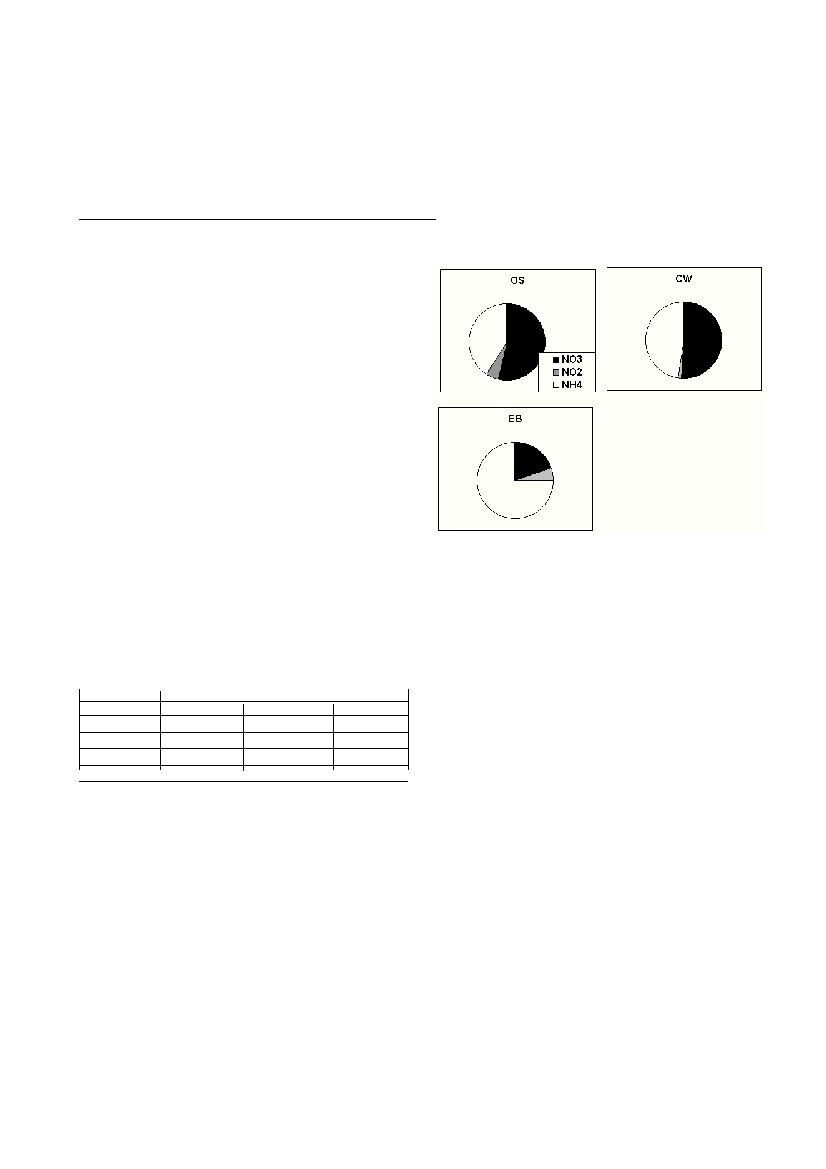Introduction
In the last decades benthic nutrient ?uxes have been intensively
studied in major oceans as well as in many coastal areas of the world.
On a global scale continental slopes have been found to be the major
deposition centres of organic matter and areas of intensive remineral-
isation (1), while in coastal areas the nutrient ?ux can be an important
source of nutrients for primary production (2). The study of benthic
nutrient ?uxes in the Adriatic Sea has been limited so far to the north-
western part of the Adriatic (3).
Material and methods
Flux measurements were performed during June 1997 – October
2000 at 12 stations in the Adriatic Sea: 3 stations were located in
eutrophic bays and estuaries (EB: 20-38 m), 5 in island channel waters
(CW: 38-82 m), and 4 in the open sea area (OS: 100-1010 m).
Sediment sampling (with overlying water) was performed by gravity
corer (Plastic tube, i.d. = 6 cm, l = 100 cm) in triplicate, while bottom-
layer seawater was sampled by a Niskin sampler.After the exchange
of sediment overlying water with collected bottom water, sediment
samples were incubated on board at the bottom layer temperature for
9-12 h. The development of concentration gradients above the sedi-
ment surface was prevented by water circulation using a peristaltic
pump. Nutrient concentration changes during the incubation were
determined by standard photometric methods using an AutoAnalyzer
II (4).
Results and discussion
Obtained average nutrient ?u
xes (J) and related standard dev
iations
(SD) for the inve
stigated areas are given in Table 1. Total nitrogen (
S
N)
in Table 1 denotes the sum of inorganic nitrate, nitrite and ammonia
?uxes. From Table 1 it is obviously that the silicate and
S
N ?u
xes
increase from the open sea area to the coastal zone, while the phosphate
?ux is approximately equal in all the areas studied. Comparing the va
l-
ues obtained with established ?u
xes in other regions, ?u
xes in the
Adriatic are in the same order of magnitude or lower than elsew
here.
Table 1. Average nutrient ?uxes in different areas of the
Adriatic Sea.
Area
J ± SD (mmol m
-2
day
-1
)
SiO
44-
PO
43-
S
N
EBE
1.45±0.650.027±0.0510.15±0.64
CW
1.02±0.530.030±0.0540.22±0.70
OS
0.87±0.470.026±0.050-0.09±0.59
Temporal changes in benthic ?uxes were also evident in all areas,
but the most prominent are in the EB area. By spliting a year into the
warm period from May to October (WPY) and the cold period from
November to April (CPY), the ratios of J
CPY
: J
WPY
for this area are 1
: 1.30 for silicate, 1 : 1.19 for phosphate and 1 : 2.64 for the
S
N - ?ux.
The spatial and temporal variations of benthic ?ux can be explained by
an existing trophic gradient from the open sea to the coastal zone (5)
as well as by temporal ?uctuations of particulate organic matter den-
sity in the water column.
Measurements of redox conditions in the sediments showed the
strong in?uence of redox potential on the phosphate ?ux. Extreme sit-
uations were found at two coastal stations where the phosphate ?ux
from sediments with positive Eh values was tenfold lower than the ?ux
from sediments with negative redox potentials. This phenomena prob-
ably can be explained by the buffering properties of Fe (III) hydrox-
ides in oxidized surface sediments (6). Beside an increase from the
open sea to the coast (Table 1), the
S
N ?ux also showed a changing
composition of nitrogen species (Fig. 1).
Figure 1. Partial nitrate, nitrite and ammonia ?ux in different
areas of the Adriatic Sea during the warm period of year
In the open sea area (OS) the nitrate ?ux dominates in the
S
N-
exchange throughout the year, while in the coastal zone (EB, CW) the
ammonia ?ux is more important, especially during the warm period of
year.As for the reason for nitrate dominated
S
N-exchange in the open
sea area (100 – 1010 m), it is assumed that, due to reduced oxygen sat-
uration in the bottom layer, nitrate in this area is an important electron
– acceptor for the oxidation of organic matter in the sediment.
References
1.Walsh J.J., 1991. Importance of continental margins in the marine
biogeochemical cycling of organic carbon and nitrogen. Nature,350:
53-55.
2. Hopkinson C.S.Jr., 1987. Nutrient regeneration in shallow-water
sediments of the estuarine plume region of the nearshore Georgia Bight,
USA.Mar. Biol., 94: 127-142.
3. Giordani P., Hammond D.E., Berelson W.M., Montari G., Poletti R.,
Milandri A., Frignani M., Langone L., Ravaioli M., Rovatti G. and Rabbi
E., 1992. Benthic ?uxes and nutrient budgets for sediments in the
Northern Adriatic Sea: burial and recycling effencies. In:Vollenweider
R.A., Marchetti R., and Viviani R. (eds.), Marine Coastal Eutrophication.
Sci.Tot. Environ. Supplement, Elsevier,Amsterdam, pp.251-275.
4. Grasshoff K., 1976. Methods of Seawater Analysis. Verlag Chemie,
Weinheim, 307 p.
5. Krstulovic N., Solic M. and Marasovic I., 1997. Relationship between
bacteria, phytoplankton and heterotrophic nano?agellates along the
trophic gradient. Helgoländer Meeresuntersuchs., 51: 433-443.
6. Sundby B., Gobeil C., Silverberg N. and Mucci A. 1992. The
phosphorus cycle in coastal marine sediments. Limnol. Oceanogr.37,
1129-1145.
Rapp. Comm. int. Mer Médit., 36,2001
140
BENTHIC FLUXES OF NUTRIENTS IN THE MIDDLE AND SOUTHERN ADRIATIC SEA
G. Kuspilic
1*
,A. Baric
1
, S. Matijevic
1
and M. Branica
2
1
Institute of Oceanography and Fisheries, Split, Croatia
2
Institute “R. Boskovic”, Center for Marine Research, Zagreb, Croatia. kuspe@izor.hr
Abstract
Benthic ?uxes of nitrogen-, phosphorus- and silica salts were determined during the period June 1997 – October 2000 in the area of middle
and south Adriatic Sea. The established ?uxes (mmol m
-2
day
-1
) were in the range from 0.16 to 1.97 for silicate; -0.038 to 0.215 for
phosphate and –1.50 to 2.88 for the sum of nitrate, nitrite and ammonia. Temporal and spatial ?ux variation showed increased values both
in the coastal zone and during the warm period of year.
Keywords: Adriatic Sea, Benthic-Pelagic coupling, Geochemical cycles

